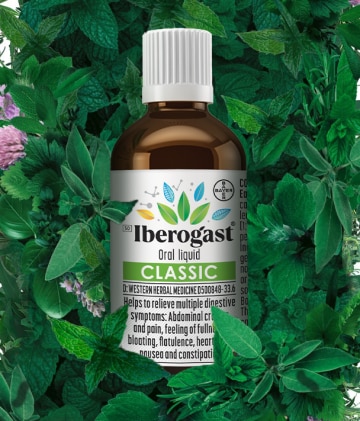Abdominal pain
Stomach pain & cramps - Causes and what you can do about them
Hardly anyone is spared: almost every person suffers at least once in the course of their life from stomach and intestinal cramps. Whether stress, improper diet or an underlying condition - the causes of stomach pain or gastrointestinal spasms can be very different. Often a disorder of the digestive tract is responsible. Find out how the symptoms develop and what measures and medications can help with gastrointestinal spasms.
Gastrointestinal cramps - what is that?
Stinging, pulling or rather pushing? Stomach pain has many facets. How it feels can be different every time - and depends mainly on the cause. No matter how you would describe this stomach pain – one thing is always the same: the location of the pain. The stomach is located on the left side of the trunk, mostly hidden under the left costal arch. If pain occurs in this region the stomach is the most likely cause behind the discomfort.
Stomach cramps - a very severe form of stomach pain - are characterized by very strong colicky pains. They usually last only for a few seconds but are so painful that the person feels as if they are being torn inside. Depending on the person, they are described as sharp, burning or cutting. Stomach cramps often occur suddenly and several times in a row.
Intestinal pain, on the other hand, is mostly a deep-seated or central pain. In most cases, the symptoms occur at the level of the belly button or even lower. Quite often noticeable rumbling accompanies the intestinal cramps. If the large intestine is affected in addition to the small intestine, the pain can also be felt just below the ribcage. In general, it is challenging to locate gastrointestinal spasms and this may result in the wrong treatment.
How stomach pain develops
The causes of stomach pain or gastrointestinal spasm are often varied.
Even when the digestive process is actually normal: As soon as chyme enters the stomach through the oesophageal sphincter (ring-shaped muscle at the entrance of the stomach), the stomach muscles start their rippling and kneading movements to mix the food. The food pulp previously minced in the mouth and mixed with saliva is stored and prepared for further digestion. The solid food then spends up to five hours in the stomach. Then it passes in portions into the intestine.
The intestine splits the chyme into its smallest, utilizable components – the nutrients. For this purpose, the digestive juices from the pancreas and the gall bladder are added directly at the beginning of the small intestine. Once they have done their job, the intestinal mucosa is able to do the absorption: thanks to its numerous folds and large surface area, it can absorb numerous nutrient components that can be used by the body and pass them on to the blood. The colon afterwards extracts the remaining fluids and excretes what cannot be utilized.
If this sophisticated system gets out of balance, it may cause stomach pain or gastrointestinal spasms.
In addition to stomach pain and gastrointestinal spasms, the following gastrointestinal symptoms may occur in parallel:
- Pressing feeling in the stomach
- Burping
- Feeling of fullness
- Heartburn
- Flatulence
- Abdominal pain
- Intestinal cramps
Handling these symptoms is often hard for the affected person - especially if the symptoms occur more frequently. Everyday life gets mixed up, the fear of new complaints can be a constant companion.
What are other triggers of stomach pain and gastrointestinal cramps?
As already mentioned, disturbed motility or hypersensitive nerves are two of the underlying mechanisms, which may be responsible for the development of symptoms in the gastrointestinal tract. These dysfunctions are, next to others, causes of an irritable stomach or irritable bowel syndrome, which are both functional gastrointestinal disorders for which no underlying organic cause can be diagnosed. Functional gastrointestinal disorders like irritable stomach and irritable bowel syndrome are characterized by symptoms like early satiety, fullness, bloating or abdominal pain.
For instance, if the nerves are hypersensitive to irritation, natural physical processes such as movement or filling of the stomach and intestines are perceived as too intense and the signals are transmitted to the brain via the sensory receptors and the nerves. The brain receives these signals, which the patient perceives as stomach pain in the upper abdomen or intestinal cramps around the navel.
A disturbed motility with slack or too tense stomach muscles can also lead to abdominal pain. If severely tense muscles are additionally stretched, for example through ingested food, the pain receptors may be irritated.
In addition, overproduction of gastric acids or even hypersensitivity to gastric acids may cause the gastric mucosa to become unbalanced. This irritation can also lead to pain perception.
Some illnesses can cause severe stomach pain as well. For example, in gastritis, the mucus layer lining the inside of the stomach is disturbed. The gastric acid can attack the gastric mucosal cells directly and in addition to the pain in the stomach can also cause other discomforts such as nausea and vomiting. The cause of gastritis may be bacteria, medications or even your own immune system.

Furthermore, the following factors or diseases may be responsible for gastrointestinal spasms:
- Irritable stomach (as introduced above)
- Infections of the gastrointestinal tract
- Flatulence
- Bloating
- Reflux
- Stomach ulcers
- Stomach cancer
If you are unsure where your symptoms are coming from or if you suspect that you have a medical condition, do not be afraid to seek out a physician. It is not easy to identify gastrointestinal issues, as many factors play a role. So your doctor will try to get the best possible picture of your situation: They will ask you about your complaints and any pre-existing illnesses. Known triggers, duration, type of pain, location and accompanying symptoms play an important role in isolating the problem as well. The physician will further ask you about your general living conditions and eating habits, stool, urination and any potential changes to your weight. Also, palpation, monitoring of gastric sounds or an ultrasound of the stomach can help them decisively in the diagnosis. Sometimes a blood test or a gastroscopy or colonoscopy is necessary.
Stomach pain in children
Children suffer relatively often from abdominal pain. Worried parents ask themselves what could be the cause of the complaints: Fatty food in the evening? A gastrointestinal virus? Or is it a simple fear of school? To rule out a physical cause, you should always consult a physician, especially if the pain persists or returns frequently.
Small children in particular often have difficulties locating the pain correctly and other parts of the body can be affected. However, if children keep complaining about having abdominal pain, it’s often caused by (school) stress. This can trigger a disturbance in their stomach movement (motility) and hypersensitivity within the gastrointestinal tract - and thus complaints such as nausea, bloating, stomach cramps and flatulence. In addition to abdominal pain, there are other symptoms that may be associated with stress, for instance:
- Insomnia
- Eating disorders
- Changes in behaviour (aggressive or withdrawn)
- Concentration deficits
- Headaches
If the reason for such a stomach pain is stress, there are measures to prevent and combat it. Try to:
- Actively listen and ask questions about worries and fears combined with offering suggestions for solutions.
- Help your child to spend his or her free time in a relaxed way - with selected activities/hobbies that are fun, with enough time for play and for friends.
- Show your child that school is a good place by encouraging him or her to attend regularly – otherwise, the problem can only get worse.
If you are unsure where the symptoms of your child are coming from or if you suspect that they have a medical condition, do not be afraid to seek out a physician!
Stomach pain when moving, running and walking
In general, exercise in everyday life and moderate sports activities promote gastrointestinal balance, so for example constipation may occur less frequently. However, some people report stomach pain after physical exertion, such as running. Science has long been concerned with the connection between sports and gastrointestinal complaints, but not all details have yet been researched. One explanation for stomach pain may be the increase in pressure in the oesophageal sphincter immediately after physical exertion. Some people perceive this as painful. But the pressure normalises within an hour of the end of the exercise.
Demanding physical activity can also influence the motility and emptying of the stomach. Some studies discuss an inhibitory effect of exercise on gastric emptying at high exercise intensity. During high exertion, there is additionally normal dehydration and an increased body temperature.
Sometimes people training for competitions load up on carbohydrates, and have higher content in the stomach during sports and may experience additional emotional stress associated with hormone release. These are all additional factors that could reduce gastric emptying - and could lead to corresponding complaints.
What to eat to alleviate stomach pain?
Many people can exacerbate their pre-existing gastrointestinal complaints because of their personal eating habits or nutrition. If the gastrointestinal tract cannot work in an optimal way, it is important to support the tract with the correct food which should be easily digestible and stomach friendly.
These include foods with fibres and good fats, like:
- lean meats and sausages (such as poultry)
- mild cheeses
- low-fat milk and egg dishes
- vegetable fats
- Fruits and vegetables such as:
- apples
- bananas
- pears
- fennel
- carrots
- courgettes are well tolerated, too.
Just as important as the right choice of food is an appropriate preparation. Suitable methods such as gentle cooking and steaming are the best ways to prepare your food. In addition, food should contain as many nutrients as possible.
Also, sufficient time should be taken to eat. To avoid overstraining the stomach, it is you better to eat several small portions throughout the day. Most important: Listen to your body – when eating certain types of food you will notice when or if to avoid them. In order to reduce stomach pain and other gastrointestinal complaints after a meal, it is essential to take a closer look at your own eating habits.
Home remedies for stomach pain
You can do a lot to treat abdominal pain within functional GI disorders that are triggered by external factors, but not caused by any organic disease. The following solutions have often proven to be effective if your complaints are triggered by nutrition or stress. They may help you alleviate the symptoms and ease your everyday life:
Avoid stress and integrate relaxed moments into your everyday life, e.g. herbal baths with added lavender or a hot-water-bottle – also slow, short walks can help you relax. If the stomach starts to rebel, a massage can also be very soothing: rub clockwise over the stomach with a flat hand for a few minutes. This pushes accumulated air further and can stimulate digestion.
Try keeping active - sufficient exercise is an important aspect of gastrointestinal symptoms: light jogging, swimming or cycling can balance digestion and is good against constipation. In general, two sport sessions per week are recommended.
As already mentioned, good nutrition is also relevant: you can try to avoid high-fat, strongly seasoned, very sweet or extremely salty dishes and all individual food that cause problems to you. Also, drink about two litres of water per day. Peppermint, caraway, fennel, aniseed and chamomile teas have a good effect on digestion, too.
In general, medicinal herbs are a good way to calm an irritable stomach. A remedy that combines 9 herbs is Iberogast® . Thanks to its combination of the extracts of medicinal plants, it can be effective on several parts of the digestive tract simultaneously (multi-target principle) and thus relieve various complaints of functional gastrointestinal disorders irritable stomach and irritable bowel syndrome. Including pain and cramps.
Fast relief: medications for stomach pain and gastrointestinal cramps
The treatment of stomach pain and cramps depends primarily on the identified cause of the pain. Therefore, a thorough investigation precedes. Here the physician asks questions about pain and lifestyle habits and examines the patient. However, the trigger is not always obvious in stomach spasms and frequently there can be more than one single factor responsible for the symptoms.
What helps against stomach pain? For a quick improvement of symptoms related to functional gastrointestinal disorders, medications that target and alleviate several symptoms and possible causes simultaneously are particularly suitable - such as Iberogast® . The concentrated power of nature has many highly effective medicinal plants at the ready. Iberogast is able to relieve numerous symptoms, by targeting several underlying mechanisms/causes at once.
In addition to stomach pain, other symptoms in the digestive tract can be treated naturally with Iberogast® . It is also useable for children aged three and over.
Iberogast® contains a combination of the following medicinal plants
- Iberis Amara (Bitter candytuft)
- Angelica root
- Caraway seeds
- Chamomile flowers
- Milk thistle fruits
- Lemon balm leaves
- Celandine
- Peppermint leaves
- Liquorice root
Patients wondering what might help them with their stomach pain can, therefore, rely on the effective and tolerable help of Iberogast® : on one hand, it helps normalize the activity of the gastrointestinal musculature, reduces hypersensitivity of the gastric nerves and so can relieve the stomach pain; and on the other, it reduces inflammation and protects the digestive tract by its mucus-protective action.
Iberogast®
Disturbances in the gastrointestinal tract are usually not only extremely unpleasant and associated with numerous complaints, they often make a normal everyday life even harder. It’s good that there is Iberogast®: The combination of nine medicinal plants targets both the underlying causes and the annoying symptoms.










